Off the Lab Bench and into the Dugout
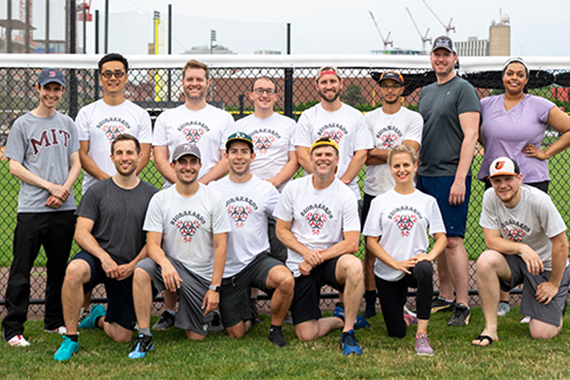
This story is part of our ongoing series, Beyond the Lab Bench. Click here to see all stories in this collection.
For over 30 years, Whitehead Institute has fielded a softball team in the Massachusetts Institute of Technology’s (MIT) Community Summer Softball league. Created in 1986, just four years after the Institute itself, the Biohazards have helped link past and former Institute personnel and provided a way for people to enjoy themselves outside the lab.
In its earlier days, the MIT league was quite large, with 10 divisions and about 70 teams.
One of the first organizers of the Biohazards in 1986 was George Daley — then a PhD student in former Institute Director David Baltimore’s lab, now dean of the faculty of Harvard Medical School. “We did have T-shirts and great team spirit, but not great hitting,” he says.
In the 1990s, the league tended to be more about fun rather than competition, says Chelle Riendeau, Senior Lawson Systems Administrator, former Biohazards captain, and former head umpire for the league. “There were a variety of skill levels. It was really about hanging out and having a good time,” she says.
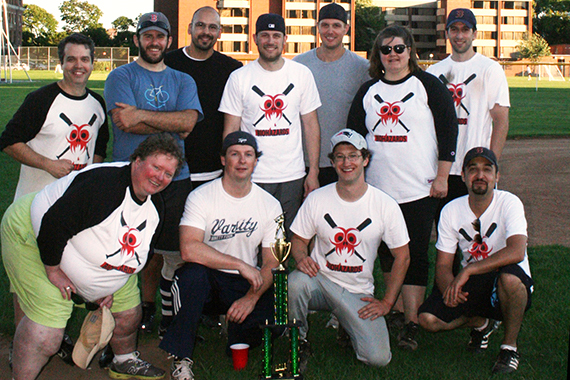
Image: Courtesy of Chelle Riendeau
Now there are just 5 divisions and 30 teams, says current team captain Tom Volkert, director of Whitehead Institute's Genome Core. “Fewer people grow up playing baseball and softball now, so you’re going to have fewer players, fewer teams,” Volkert says. “But the remaining teams take the game a little more seriously.”
The Biohazards have had a number of strong showings in the playoffs in Volkert’s nearly 20-year run as team captain. “We’ve had some epic eras,” says Volkert. “You see these four trophies up there —” he keeps the championship trophies on a shelf in his office — “they’re from 2011 to 2014. We had a run of dominance there.” The ’Hazards had a rivalry with a team from the Broad Institute for a number of years, with a few dramatic showdowns. “Eventually we got to be friends, because we realized it was fun to have this kind of competition,” Volkert says.
The team has developed a core group of players, some of them on the roster as long as Volkert. “It’s a great way to have some continuity and some connection to the past at Whitehead,” he says. Nonetheless, Volkert is always looking for new recruits. “We still welcome anyone who wants to play, regardless of skill level,” he says. “We enjoy having them and working them into the game, teaching fundamentals.” The younger players also get to network with alumni that have moved on to new positions in industry or academia, he adds.
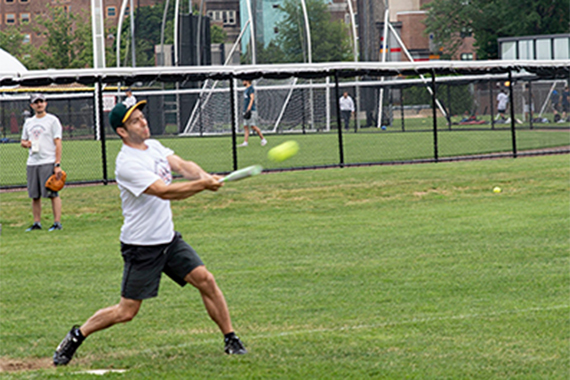
The Biohazards of today are not your typical rec-league softball team, swinging for the fences at every pitch and not putting much effort into defense. “I probably spend way too much time thinking about strategy, but I do think it makes a difference,” says Volkert. “One of the key things there is knowing the strengths and weaknesses of your players and putting them in a position where they can succeed. Softball is a beautiful sport in that you have ten different defensive positions out there, and each one is pretty different in the types of skills that it requires. There’s a place for everyone on the field.”
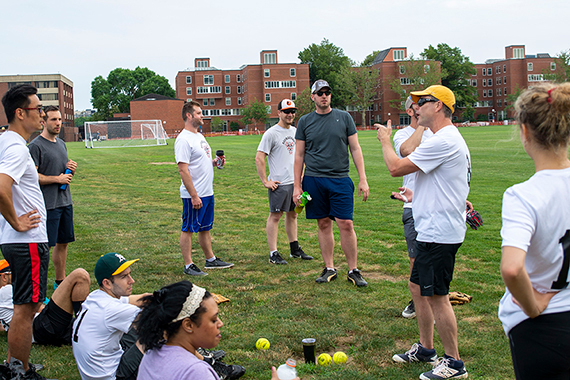
Image: Conor Gearin/Whitehead Institute
Keeping the opponents’ batters guessing is Volkert’s usual role on defense. His signature pitch: throwing it high so that the ball arrives at a steep angle but still within the strike zone. “People tend to really underestimate how important pitching is in softball — they have this impression that pitchers are just lobbing the ball,” he says.
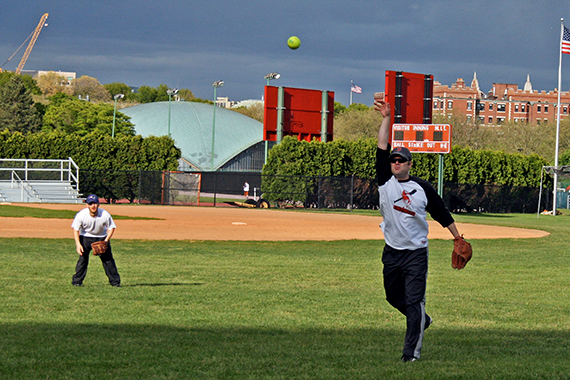
Image: Courtesy of Chelle Riendeau
“We are so lucky to be able to play on these beautifully manicured fields that MIT gives us access to,” Volkert says. “On a hot summer evening, you can hear the din of the crowd from Fenway on game days. It’s just a really special opportunity to be out there.”
Volkert says that social activities like the Biohazards are an important part of a balanced life for researchers. “It really is important to get out of the lab and hang out with friends and even coworkers outside of a work environment, and this is a perfect opportunity for that,” he says. “It gets them out of the lab, gets them talking about things other than science, although science does seem to come up all the time — but that’s scientists for you.”
“It’s a good way to meet the scientists as someone that works in administration,” says Riendeau. “It’s nice to have that connection. It’s also a way for people from different labs to meet each other. It’s a good way to build community without the pressure of research.”
In the current season, the ’Hazards are entering the playoffs leading their division with a record of 7-2. The first playoff game is Monday night at 5:30 on MIT field 5A (near Burton-Conner House). The team has its sights set on the championship and adding a fifth trophy to its collection.
Contact
Communications and Public Affairs
Phone: 617-452-4630
Email: newsroom@wi.mit.edu


